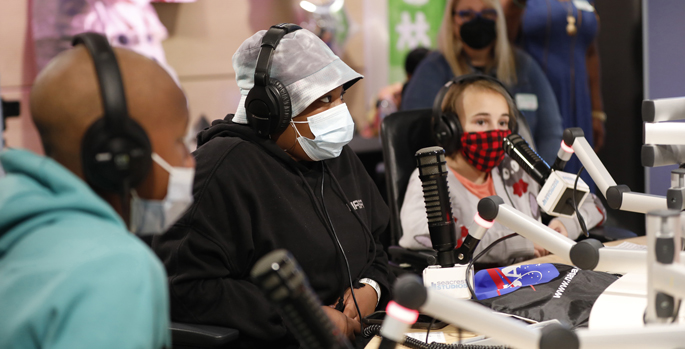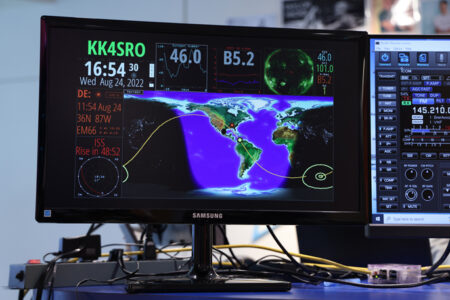
by Christina Echegaray
“Monroe Carell Jr. Children’s Hospital at Vanderbilt to International Space Station, do you copy? Over.”
For six minutes on Aug. 24, patients of Monroe Carell Jr. Children’s Hospital at Vanderbilt went out of this world — or at least their voices did.
The patients, also students of the hospital’s school program, connected via amateur radio with NASA astronaut Kiell Lindgren, MD, who was aboard the International Space Station (ISS) as it passed over Tennessee.
To earn this rare opportunity for “The Call,” Monroe Carell’s school program, along with the hospital’s Seacrest Studio and local Amateur Radio Operators, drafted and submitted a lengthy proposal that included a detailed education plan to the Amateur Radio on the International Space Station (ARISS) program.
The ARISS program is designed to engage young people in science, technology, engineering, arts and math (STEAM) activities and raise their awareness of space communications, radio communications, space exploration and related areas of study and career possibilities. About 60-80 special amateur radio contacts are made each year between students around the globe and crew members with ham radio licenses aboard the ISS. Monroe Carell was one of eight programs selected in the latest round of applications.
“The Call” was the culmination of two and a half years of planning, teaching and waiting, after the two previous attempts to participate were paused due to COVID-19.
“We are honored and excited to be picked among a select group of schools to participate in this program,” said Tisha Coggin, a teacher for the hospital school program, which serves about 80 students weekly. “A huge team effort went into making this possible, starting with the collaboration with our Seacrest Studio colleagues in 2019. We’re so thankful that Brian Clark with the Ryan Seacrest Foundation brought this opportunity to our attention and so ready to have our turn to talk to the astronauts on the ISS.”
Sitting at microphones inside Seacrest Studios, four students had about six minutes to ask the astronaut questions.
“How much do you talk to your family? Over,” asked patient Aaliyah Broome, 13.
“We have terrific technology here,” Lindgren said, adding that he can talk frequently with his family, including through video calls.

Patient Walter Mayo, 7, wanted to know what happens if you get sick in space. Luckily, Lindgren noted, they try to make sure the astronauts are as healthy as possibly before going to space, and if they don’t feel well on board, he’s a doctor.
There was a question posed to Lindgren about signs of alien life. Oddly enough, that was the only answer where the audio was garbled.
After the approximate time allotted, the signal, transmitted through an antenna atop the hospital building, dropped due to the positioning of the ISS. The antenna and supplies were donated for the call by the Williamson County Amateur Radio Club. Local Amateur Radio Operator, Randy Moore, coordinated the connection with Lindgren.
Just before the connection ended, Lindgren closed by saying “Thank you so much. Thank you for letting me be a part of your day, and thank you for facilitating this contact. Over.”
The school program had stations set up outside Seacrest Studio where patients explored hands-on activities to learn about the solar system and size and how sound waves function. There was also a photo booth and space-related giveaways from NASA’s Marshall Space Flight Center in Alabama.
“One small step with the International Space Station was a giant leap for ARISS, Seacrest Studios, and Monroe Carell Jr. Children’s Hospital at Vanderbilt,” said Mamie Shepherd, program manager for Seacrest Studio.
“The Amateur Radio on the International Space Station Program provided a way for dreamers undergoing medical treatment and therapy in Nashville to talk to a real-life astronaut aboard the ISS as it passed over Tennessee. What a thrill for Seacrest Studios! Twinkle, Twinkle Little Star has a whole new meaning for us after a touch with a world many miles away. Thanks to NASA, ARISS and local HAM radio operators, the Ryan Seacrest Foundation, and the hospital school program,” Shepherd said.












